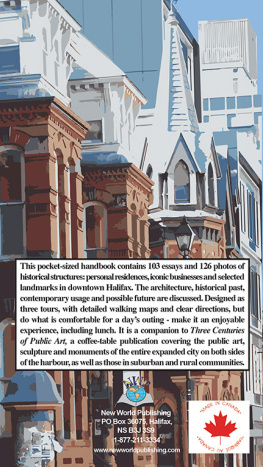CHAPTER I.
Table of Contents
Halifax, the metropolis of Nova Scotia, and the chief City of the Acadian or Lower Provinces, was founded in the year 1749, at the expense of Government, under the direction of the Lords of Trade and Plantations, and was named in compliment to George Montague, Earl of Halifax, then at the head of the Board, under whose immediate auspices the settlement was undertaken.
From the Treaty of Utrecht, in 1713, when Acadia was ceded to the Crown of Great Britain, to the year 1749, no progress had been made by the British in colonizing the country. The inhabitants consisted of a few thousand Acadian peasants, scattered around the shores of the Basin of Minas, Chignecto and the Valley of Annapolis. The Governor resided at Annapolis Royal, a small fortified port, with a garrison of two or three hundred regular troops, and was, in a great measure, dependent on New England for his necessary supplies. This was the only British port within the Province, with the exception of that of Canso, where, during the fishing season, a number of French, with a few Indians and New England fishermen, assembled, and where a captain's guard was usually stationed to preserve order and protect the rights of property. The French population, though professing to be neutral, had refused to take the Oath of Allegiance to the Crown of Great Britain, and were continually in a state of hostility to the British authorities in the country. Their poverty and ignorance placed them completely under the control of a few designing emissaries of the French Governor at Quebec, who incited the people to resent British rule, and frequently put all law at defiance, by assuming to themselves the sole management of municipal affairs in the settlements most remote from the seat of Government. The Governors of Canada had undertaken to claim all the country from the River St. Lawrence to the Bay of Fundy, as comprehended within their jurisdiction, confining the territory of Acadia as ceded under the Treaty of Utrecht, to the Peninsula alone, and had actually commenced to erect forts on the River St. John and the Isthmus while the nations were at peace.
The necessity of a permanent British settlement and Military Station on the Atlantic Coast of the Peninsula, had long been considered the only effectual means of preserving British authority, as well as for the protection of the coast fishing, which, at this time, was deemed of paramount importance to British interests. But lately the continual breaches of neutrality on the part of the French, together with the loss of Louisburg, under the Treaty of Aix-la-Chappelle, in October, 1748, rendered such an establishment indispensably necessary to the support of the British Crown in Nova Scotia.
The scheme for settlement at Chebucto is said to have originated with the people of Massachusetts,
A plan for carrying into effect this long-cherished design was, however, matured by the Board of Trade and Plantations, in the year 1748, and submitted to Government in the autumn of that year, and being warmly supported by Lord Halifax, the President of the Board, advertisements soon appeared under the sanction of His Majesty's authority, "holding out proper encouragement to officers and private men lately discharged from the Army and Navy, to settle in Nova Scotia." Among other inducements was the offer to convey the settlers to their destination, maintain them for twelve months at the public expense, and to supply them with arms and ammunition for defence, and with materials and articles for clearing the land, erecting dwellings and prosecuting the fishery. The encouragements appeared so inviting, that in a short time 1176 settlers, with their families, were found to volunteer, and the sum of 40,000 being appropriated by Parliament for the service, the expedition was placed under the command of Col. the Honble. Edward Cornwallis, M. P., as Captain General and Governor of Nova Scotia, and set sail for Chebucto Bay, the place of destination, in May, 1749.
The fleet consisted of 13 Transports and a Sloop of War. The following is a list of the vessels, with the number of settlers.
| Sphinx Sloop of War, with Gov. Cornwallis and Suite. | Tonnage. | Number of
Passengers. |
|---|
| Transports. | Captains. |
|---|
| Charlton Frigate | Richard Ladd | 395 | 213 |
| Winchelsea | Thomas Cornish | 559 | 303 |
| Wilmington | Thomas Adams | 631 | 340 |
| Merry Jacks | Granger | 378 | 230 |
| Alexander | Samuel Harris | 320 | 172 |
| Beaufort | Elias Brennan | 541 | 287 |
| Rochampton | Samuel Williamson | 232 | 77 |
| Cannon Frigate | Andrew Dewar | 342 | 190 |
| Everly | S. Dutchman | 351 | 186 |
| London | John Barker | 550 | 315 |
| Brotherhood | .... | .... | 27 |
| Baltimore | Edward Cook | 411 | 226 |
| Snow Fair Lady | Isaac Foster | .... | 10 |
| 2576 |
The total number of males, exclusive of children, was 1546; of this number above 500 were man-of-war sailors.
The names of the principal settlers, with the rank and calling as they appear in the register, are as follows:
Leonard Lockman and Ezekiel Gilman, Majors in the Army; John Lemon, Foot Major and Commissary; Otis Little, Edward Amherst, Thomas Lewis, Benjamin Ives, Frederick Albert Strasburger, and Francis Bartelo, Captains in the Army; David Lewis, George Burners, George Colly, Richard Partridge, Thomas Newton, John Collier, Robert Ewer, John Creighton, Thomas Voughan, John Galland, Richard Reves, William Joice, Joseph Wakefield, Augustus Graham, Alexander Callendar, David Haldame, Robert Campbell, William Bryan, and T. Vaughan, Lieutenants in the Army; James Warren, Thos. Reynolds, and Henry Wendell, Ensigns; John Hamilton, Adam Cockburn, and Wm. Williams, Lieutenants in the Navy; John Steinfort, Dennis Clarke, William Neil, Gustavus Mugden, and John Twinehoe, Lieutenants of Privateers; Chas. Mason, Robert Beatie, Charles Covy, Samuel Budd, John Ferguson, Nicholas Puxley, William Watson, Joseph Tomwell, Henry Chambers, Nicholas Todd, Roger Lowden, Joseph Gunn, John Thompson, Robert Young, Thomas Burnside, Timothy Pearce, Richard Drake, Newbegin Harris, William Vickers, Richard Cooper, Richard Mannering, Thomas Dumster, and Robert Cockburn, Midshipmen in the Royal Navy; John Jenkins, Cadet; Rene Gillet, Artificer; John Grant, John Henderson, Edward Gibson, William Hamilton, and William Smith, Volunteers; Lewis Hayes, Purser; John Bruce, Engineer; William Grant, Robert White, Patrick Hay, Mathew Jones, Thomas Wilson, M. Rush, James Handeside, H. Pitt, George Philip Bruscowitz, Cochran Dickson, Joshua Sacheveral, Thomas Inman, John Wildman, David Carnegie, and John Willis, Surgeons; John Steele, Lieutenant and Surgeon; William Lascells, Augustus Carsar Harbin, Archibald Campbell, John Wallis, John Grant, Daniel Brown, Timothy Griffith, Henry Martin, Robert Grant, and Alexander Hay, Surgeon's Mates and Assistants; Robert Thorckmorton, Surgeon's Pupil; Mr. Anwell, Clergyman;














